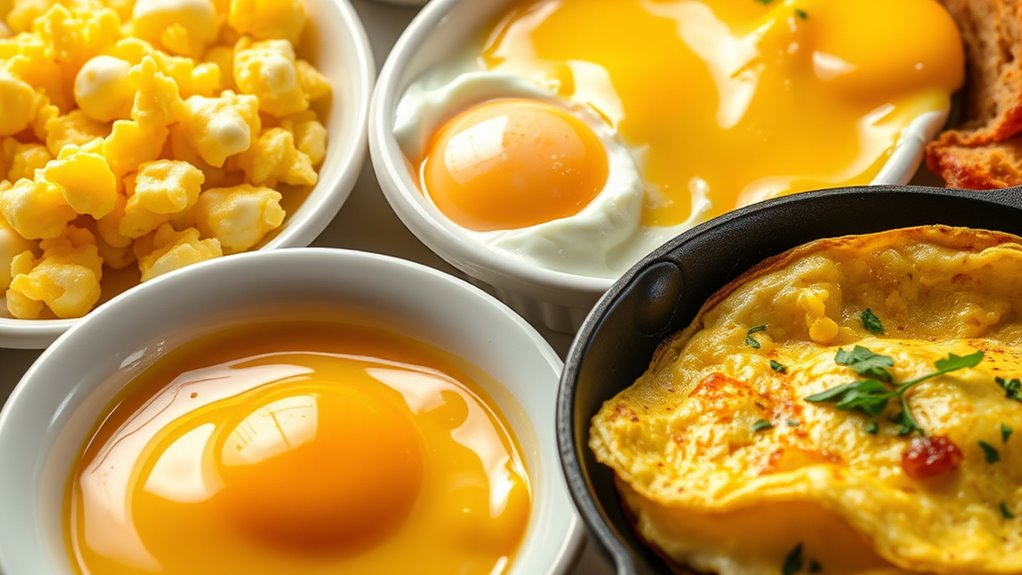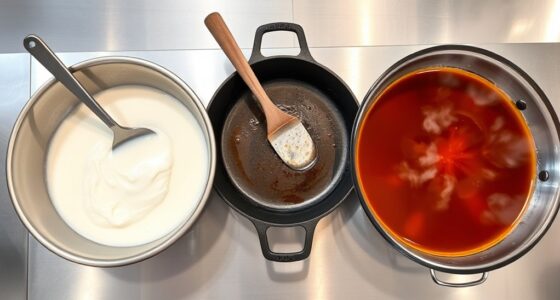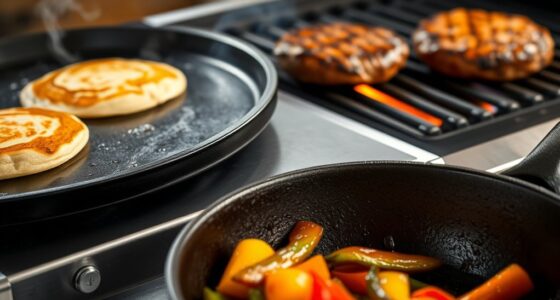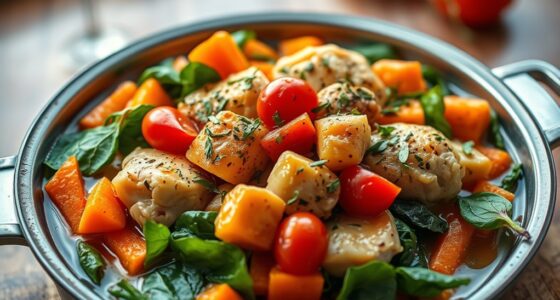To master scrambling, poaching, frying, and making omelettes, focus on proper technique, heat control, and timing. Whisk eggs thoroughly for fluffy scramble, cook gently over medium-low heat, and add your favorite fillings for perfect omelettes. For poached eggs, add vinegar to simmering water and handle with care for tender whites. Mastery comes from practicing these methods to achieve ideal textures and flavors, so keep experimenting to uncover your peak egg-cooking skills.
Key Takeaways
- Master heat control and timing to achieve perfect texture and prevent overcooking or undercooking eggs.
- Whisk eggs thoroughly and cook gently for fluffy scrambled eggs and tender omelettes.
- Use vinegar in water for delicate, neatly shaped poached eggs.
- Control cooking temperature and flip timing for desired fried egg doneness (sunny-side-up, over-easy, over-hard).
- Practice each technique regularly to refine handling, improve results, and elevate your egg dishes like a pro.
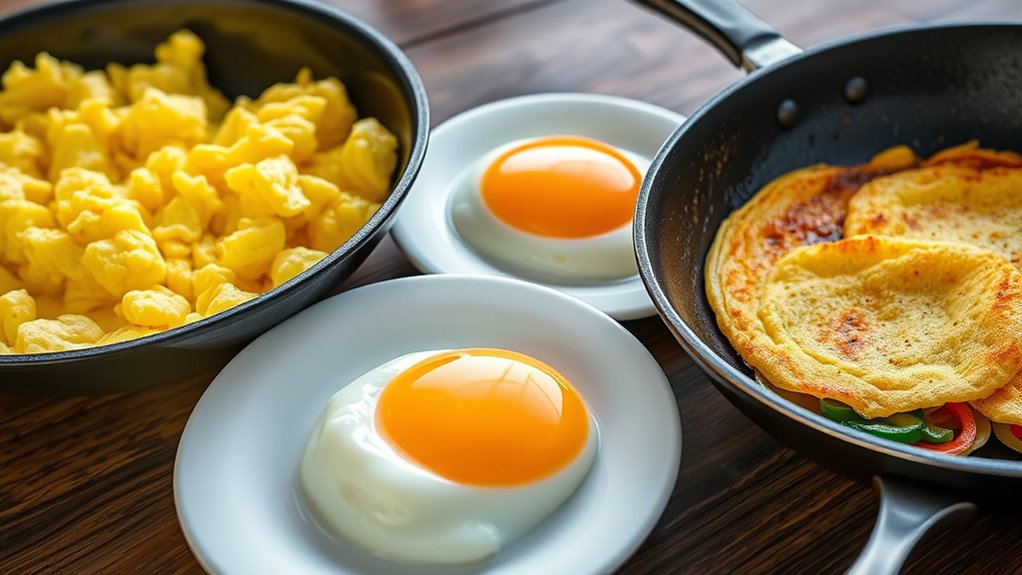
Egg Mastery
Have you ever wondered how to turn a simple egg into a culinary masterpiece? Eggs are incredibly versatile and packed with essential nutrients, making them a fantastic ingredient to elevate your meals. With a little knowledge of egg nutrition and proper egg cooking techniques, you can transform this humble ingredient into a delightful dish that impresses everyone. Eggs are rich in high-quality protein, vitamins like B12 and D, and minerals such as selenium and choline. These nutrients support brain health, boost your immune system, and provide sustained energy. Knowing how to cook eggs correctly helps preserve these benefits while bringing out their best flavors and textures.
Eggs are nutrient-rich and versatile, perfect for elevating any meal with proper cooking techniques.
When it comes to egg cooking techniques, mastering the basics is key. Whether you’re scrambling, poaching, frying, or making an omelette, each method requires specific steps to achieve excellent results. For scrambled eggs, whisk your eggs well with a splash of milk or cream to create a creamy consistency. Cook them over medium-low heat, stirring gently to prevent sticking or burning, resulting in soft, fluffy curds. Poaching eggs involves delicate handling; crack an egg into simmering water with a splash of vinegar, and cook until the whites are set but the yolk remains runny. This technique yields a tender, elegant presentation perfect for brunch or atop salads.
Frying eggs is straightforward but demands attention to heat and timing. Use a non-stick skillet, add a small amount of butter or oil, and cook over medium heat. For sunny-side-up eggs, cook until the whites are fully set but the yolk stays runny. Flip them for over-easy or over-hard eggs, depending on your preference. Omelettes are all about technique—beat your eggs thoroughly, pour into a hot, lightly oiled pan, and cook until the edges start to lift. Add fillings like cheese, vegetables, or meats, then fold and serve hot. Proper temperature control and timing are vital across all techniques to prevent rubbery eggs or undercooked centers.
Understanding egg nutrition helps you appreciate their health benefits and encourages thoughtful cooking. For example, lightly cooking eggs retains most nutrients, while overcooking can diminish some vitamins. Using the right technique also ensures you maximize flavor and texture, turning a simple egg into a culinary achievement. Additionally, proper heat management during cooking plays a crucial role in achieving the desired egg consistency without compromising their nutritional integrity. Remember, practice makes perfect. With each method, you’ll learn how heat, timing, and handling influence your results. Whether you’re aiming for creamy scrambled eggs, perfectly poached eggs, crispy fried eggs, or fluffy omelettes, mastering these egg cooking techniques will elevate your breakfast game and boost your confidence in the kitchen. Once you get the hang of it, you’ll see that turning an everyday ingredient into a gourmet dish is easier than you think.
Frequently Asked Questions
What Are the Best Eggs for Different Recipes?
You should choose eggs based on your recipe and preferences. For richer flavor, opt for pasture-raised eggs, while organic eggs are great for health-conscious cooking. Brown eggs often have thicker shells, but shell color doesn’t affect quality. Store eggs in their carton in the fridge to keep them fresh. Use fresher eggs for poaching and scrambling, and slightly older eggs for easier peeling when making omelets or frying.
How Do I Prevent Eggs From Sticking?
To prevent eggs from sticking, use a non-stick coating on your pan and make sure it’s properly heated before adding eggs. Lightly greasing the surface with butter or oil also helps. Master egg release techniques by gently loosening the edges with a spatula and giving the pan a gentle shake. These steps create a smooth surface, making your eggs slide off effortlessly and keeping your cooking clean and easy.
What’s the Ideal Pan for Each Cooking Method?
You should choose a non-stick coated pan for scrambling and frying eggs, as it guarantees easy release and prevents sticking. For poaching, a deep, stainless-steel or non-stick pan with good heat distribution works best, helping maintain a consistent temperature. Omelettes benefit from a non-stick skillet that distributes heat evenly, preventing hot spots. Select the right pan to make your egg cooking seamless and perfect every time.
How Can I Tell if Eggs Are Fresh?
To tell if eggs are fresh, trust your nose and a quick freshness test. If they smell off, toss them out. For a freshness test, fill a bowl with cold water and gently place the egg in. If it sinks and lies flat, it’s fresh; if it stands upright or floats, it’s past its prime. Proper egg storage extends freshness, so keep eggs in the coldest part of your fridge.
Are There Healthy Alternatives to Traditional Eggs?
Yes, there are healthy alternatives to traditional eggs. You can try plant-based substitutes like tofu, chickpea flour, or commercial egg replacers, which offer similar textures and flavors. Nutritional comparisons show these options are often lower in cholesterol and saturated fats, making them heart-healthier choices. Incorporate these into your cooking for a nutritious, ethical, and delicious way to enjoy your favorite dishes without eggs.
Conclusion
Mastering eggs means mastering versatility, mastering simplicity, and mastering confidence. When you scramble, poach, fry, or make an omelette, you’re not just cooking—you’re creating. With each technique, you gain more skill, more flavor, more pride. Keep practicing, keep experimenting, keep improving. Because when you master eggs, you master breakfast, you master breakfast, you master breakfast. And that’s the secret to turning everyday eggs into extraordinary meals.
